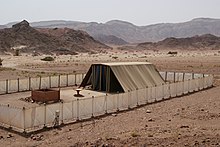Mishan

The Mishkan ( Hebrew מִשְׁכַּן "flat") or the Tabernacle or the tabernacle (Heb. אֹהֶל מוֹעֵד ʔohel mōʕēd ) is the portable shrine which according to the Tanach , the Jewish Bible, the people of Israel in his wanderings after the Exodus from Egypt was bringing before a permanent central sanctuary was established.
Names
Mischkan ( Ex 26.1 EU ) is just one of several names for the transportable sanctuary. "Mishkan" means "apartment" and is linguistically from the root שׁכן shakhan , "to live", derived (like Schechina ). In a narrower sense, mischkan only refers to the gilded timber structure over which the tent is then to be placed ( Ex 26.7 EU ).
Other biblical names of the place of worship are Miqdasch (מִקְדָּשׁ, Ex 25.8 EU , "Sanctuary"), Ohel HaEdut (אֹהֶל הָעֵדוּת, Num 17,22 EU , "Tent of Testimony") and Ohel Moed (אֹהֶל מוֹעֵד, Ex 27.21 EU ). The latter is the designation that can be translated as "tent of meeting" , "tabernacle" (according to the Luther translation ) or "tent of meeting".
The Bible text does not always clearly differentiate between these designations. In Ex 39.32 EU, for example, there is talk of the Mishkan of Ohel Moed , that is, the “apartment of the tabernacle”. The Septuagint translated Mishkan and Ohel with the same word σκηνὴ ( skänä , "tent"), which corresponds to Ohel in terms of content , but sounds like Mishkan . Ohel Moed and Ohel HaEdut are represented equally as σκηνὴ μαρτυρίου ( skänä martyriu ), “tent of testimony”. Hieronymus followed this example in his Latin translation by translating both Ohel and Mishkan with tabernaculum . This was later followed by the King James Version , which reproduces both with tabernacle .
meaning
The regulation for building the sanctuary is traced back to Ex 25.8 EU , where it says: “Make me a sanctuary! Then I will dwell in their midst. ”According to Jewish tradition, the expression“ in their midst ”suggests that the sanctuary is not to be understood as the abode of God, but as a symbol of the holiness of God, which the people had to live up to. when his spirit should dwell in their company. The tent served the Israelites during their wandering in the desert and up until the time of King David as a central place to meet God. At first it was carried along on the hikes, later it was located in Shiloh, roughly in the middle of the land of Israel. After David had conquered Jerusalem from the Jebusites and made it the capital of Israel, he had the tent sanctuary brought there. Later it was possibly kept in disassembled form in the Temple of Solomon ; At the latest with the destruction of this temple it was lost.
Structure of the Mischkan
The size specifications are given in the Bible in cubits , the current equivalent of 45 cm and 52.5 cm. According to the biblical description, the tabernacle was 30 cubits long, ten cubits high, and ten cubits wide. Inside was the Holy of Holies and the Holy , which was twice as long as it was wide. The construction consisted of truss frames. It was made of acacia wood covered with gold . Linen blankets on which colorful cherubim were embroidered were hung over this frame . On the linen blankets lay goat hair blankets , on top of which were blankets made of red-dyed ram skins and finally blankets made of seal skins (or manatee skins or skins , or something else; the exact translation of the corresponding Hebrew word tahash is no longer known today).
The Holy
At the entrance to the saint (קֹדֶשׁ Kodesh ) stood five pillars covered with gold . In the saint were the golden candlestick , the golden altar for the incense offering and the golden showbread table with the associated utensils.
Holy of Holies
The holy of holies, Kodesh HaKodashim (קדש הקדשים literally "the sanctuary of sanctuaries"), was separated by a curtain within the sanctuary. It was only entered by the high priest once a year on Yom Kippur . In the Holy of Holies stood the Ark of the Covenant , which was covered with a lid with two cherubim at the ends .
Forecourt
The tabernacle was surrounded by a courtyard that was 100 by 50 cubits. The forecourt was surrounded on the outside by a five ells high wall of linen, which was attached to copper pillars. In the forecourt stood the altar of burnt offerings and a copper basin that was filled with water for the priests to wash.
New Testament reference
The tabernacle is mentioned several times in the New Testament under the name "sanctuary" in Hebrews . According to Heb. 8.2 EU , Jesus serves as the true high priest in heaven, which is the true sanctuary of God. The sanctuary built by people is therefore only the reflection of the heavenly tabernacle ( Heb. 8.5 EU ).
See also
- Tabernacle , the place where consecrated hosts are kept in Catholic churches
Web link
Individual evidence
- ^ Pentateuch and Haftaroth with commentary by Dr. Hertz, Verlag Morascha Zürich 1984, Volume II, p. 296
